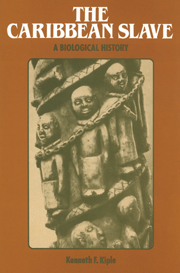11 - Epilogue: Diet, Disease, and Displacement
Published online by Cambridge University Press: 19 October 2009
Summary
Reproaching the victim for the consequences of his victimization antedated slavery and has outlived it.
Sidney W. Mintz (1974)Demographic predominance is no panacea; problems of colour continue to affect West Indian society, culture and personality.
David Lowenthal (1972)At their most virulent, diseases such as yellow fever and malaria were killers of hundreds of thousands of Europeans in the West Indies. In this century the diseases have receded, due to preventive and therapeutic medicine, and memories have dimmed of the terror they wrought. However, the current low state of these diseases is not assured for the future. Yellow fever remains very much alive in the treetops of nearby South America and there is still no specific treatment for the disease; malaria is on the offensive throughout the world and mosquito vectors for both yellow fever and malaria are plentiful throughout the Caribbean.
Were both diseases once again to assume hurricane intensity and sweep the Islands, they would surely overwhelm modern medicine, at least temporarily. Were it yellow fever, hospitals could overflow and only a small percentage of the victims might ever reach exhausted physicians and nurses. The imagination can conjure up scenes of airports and docks jammed with persons attempting to flee and riots when no planes or boats appeared because the island was quarantined. The cities would fall quiet as individuals huddled fearfully indoors–a quiet broken only by the sound of trucks, pressed into service for transporting the dead.
Fanciful or not the scenario may help those of us in this century to comprehend the terror of a yellow fever epidemic in centuries past.
- Type
- Chapter
- Information
- The Caribbean SlaveA Biological History, pp. 177 - 188Publisher: Cambridge University PressPrint publication year: 1985

